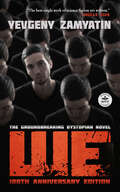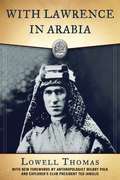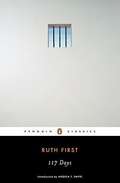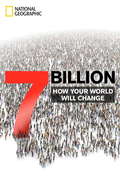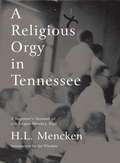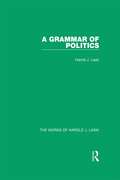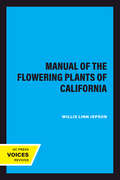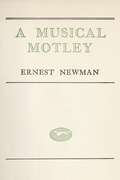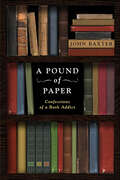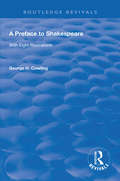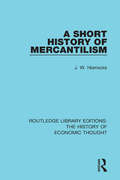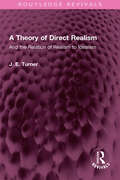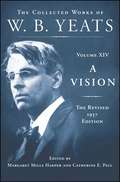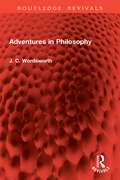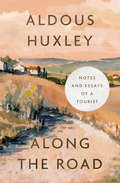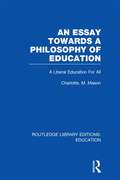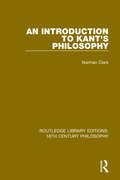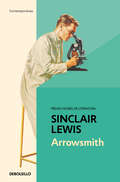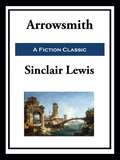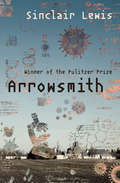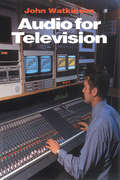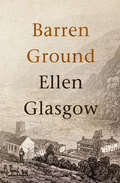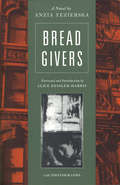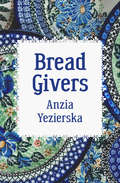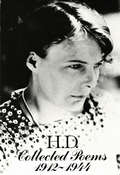- Table View
- List View
We: 100th Anniversary Edition
by Yevgeny ZamyatinThe groundbreaking dystopian novel that inspired 1984 and Brave New World. &“The best single work of science fiction yet written.&” —Ursula K. Le Guin When society has programmed you to sleep . . . How do you wake yourself up? The One State is a world where people are merely numbers, and free will itself is a disease. Most are happy in their role as cogs in a huge machine, controlled by the ever-watchful Benefactor. However, on the eve of the launch of the Integral—the spacecraft that will impose the One State&’s way of life everywhere—starship architect D-503 meets I-330, a female number as irreverent as she is beautiful. The Benefactor has quantified human experience, circumscribed edit, reduced it to nothing but a series of mathematical equations—that is, until one man tries to factor in the ultimate unknown: love. Before Huxley. Before Orwell. There was Zamyatin. Discover it for yourself today. Bonus: includes Zamyatin&’s famous &“Death Sentence Appeal&” letter to Stalin, and &“Love Is the Function of Death&” a bold new essay by noted science fiction author, reviewer, and scholar Paul Di Filippo. &“How could I have missed one of the most important dystopias of the 20th century? . . . I was amazed by it.&” —Margaret Atwood &“One of the literary curiosities of this book-burning age.&” —George Orwell
With Lawrence in Arabia (Explorers Club Classics)
by Lowell Thomas Mitchell StephensIn 1918, as the First World War ravaged the European continent, young American journalist Lowell Thomas traveled to the Ottoman Empire to report on the revolts breaking out as an indirect result of the savage European conflict. While in Jerusalem, he met and struck up a friendship with the infamous young British captain, T.E. Lawrence. Based on his travels and interviews with Lawrence, Thomas wrote the now classic With Lawrence in Arabia, the book that spawned the Lawrence of Arabia legend and served as the basis for the award-winning 1961 film of the same name.Fantastically paced with equal measures of fact and adventure, Thomas narrates the exploits of the infamous British agent who against all odds managed to join several factious Arabian tribes into a single combat unit. With Lawrence in command, this guerilla force would go on to defeat the great Turkish Army and ensure the eventual demise of the previously impenetrable Ottoman Empire.On the sweeping and the exotic Arabian desert that serves as the setting for this epic account, Thomas brings to life dozens of great historical figures including Emir Feisel, King Hussein I of Hedjaz, British General Edmund Alleby, and Lawrence, the enigmatic, "modern knight of Arabia.” With new forewords by modern explorers, this Explorer’s Club Classic edition of With Lawrence in Arabia is a must-have for every history buff and arm-chair adventurer.
117 Days
by Ruth FirstIn August 1963 Ruth First was arrested and detained in solitary confinement under the 90-Day Law for a total period of 117 days, following arrests of members of the underground ANC. The book tells about the 117 days.
7 Billion: How Your World Will Change
by National GeographicIn late October 2011, the 7 billionth citizen of planet Earth was born. To mark the event, National Geographic magazine commissioned seven articles that explore the fascinating issues - including demographics, food security, climate change, fertility trends, managing biodiversity - surrounding this topic, which are collected for the first time in this special ebook. Environment editor Robert Kunzig starts by sketching out a natural history of population. The issues associated with population growth seem endless: poverty, food and water supply, world health, climate change, deforestation, fertility rates, and more. In additional chapters Elizabeth Kolbert explores a new era - the "Anthropocene," or the age of man - defined by our massive impact on the planet, which will endure long after our cities have crumbled; and takes us to the Mediterranean, where she delves into issues associated with increasing ocean acidification. In Bangladesh, Don Belt explores how the people of this crowded region can teach us about adapting to rising sea levels. In "Food Ark" we travel deep within the earth and around the globe to explore the seed banks that are preserving the variety of food species we may need to increase food production on an increasingly crowded planet. In Brazil, Cynthia Gournay explores the phenomenon of "Machisma" and shows how a mix of female empowerment and steamy soap operas helped bring down Brazil's fertility rate and stoke its vibrant economy. Additionally we explore threats to biodiversity, and the return of cities - which may be the solution to many of our population woes. Join National Geographic on this incredible journey to explore our rapidly growing planet.
A Religious Orgy in Tennessee
by H. L. Mencken Art Winslow"The native American Voltaire, the enemy of all puritans, the heretic in the Sunday school, the one-man demolition crew of the genteel tradition." -Alistair Cooke on H.L. Mencken Fiercely intelligent, scathingly honest, and hysterically funny, H.L. Mencken's coverage of the Scopes Monkey Trial so galvanized the nation that it eventually inspired a Broadway play and the classic Hollywood movie Inherit the Wind. Mencken's no-nonsense sensibility is still exciting: his perceptive rendering of the courtroom drama; his piercing portrayals of key figures Scopes, Clarence Darrow, and William Jennings Bryan; his ferocious take on the fundamentalist culture surrounding it all--including a raucous midnight trip into the woods to witness a secret "holy roller" service. Shockingly, these reports have never been gathered together into a book of their own--until now. A Religious Orgy In Tennessee includes all of Mencken's reports for The Baltimore Sun, The Nation, and The American Mercury. It even includes his coverage of Bryan's death just days after the trial--an obituary so withering Mencken was forced by his editors to rewrite it, angering him and leading him to rewrite it yet again in a third version even less forgiving than the first. All three versions are included, as is a complete transcript of the trial's most legendary exchange: Darrow's blistering cross-examination of Bryan. With the rise of "intelligent design," H.L. Mencken's work has never seemed more unnervingly timely--or timeless.
A Grammar of Politics (The Works of Harold J. Laski)
by Harold J. LaskiLaski’s magnum opus, this volume outlines the history and functions of state institutions which (in the author’s view) are desirable for the effective functioning of a democracy. Topics discussed include: The necessity of government; state and society; rights and power; liberty and equality; property as a theory of industrial organisation; the nature of nationalism; law as a source of authority; the functions of international organisations.
A Manual of the Flowering Plants of California
by Willis Linn JepsonThis title is part of UC Press's Voices Revived program, which commemorates University of California Press’s mission to seek out and cultivate the brightest minds and give them voice, reach, and impact. Drawing on a backlist dating to 1893, Voices Revived makes high-quality, peer-reviewed scholarship accessible once again using print-on-demand technology. This title was originally published in 1925.
A Musical Motley
by Ernest NewmanThis is a reproduction of a book published before 1923. This book may have occasional imperfections such as missing or blurred pages, poor pictures, errant marks, etc. that were either part of the original artifact, or were introduced by the scanning process. We believe this work is culturally important, and despite the imperfections, have elected to bring it back into print as part of our continuing commitment to the preservation of printed works worldwide. We appreciate your understanding of the imperfections in the preservation process, and hope you enjoy this valuable book.
A Pound of Paper: Confessions of a Book Addict
by John BaxterIn the rural Australia of the fifties where John Baxter grew up, reading books was disregarded with suspicion, owning and collecting them with utter incomprehension. Despite this, by the age of eleven Baxter had 'collected' his first book - The Poems of Rupert Brooke. He'd read the volume often, but now he had to own it. This was the beginning of what would become a major collection and a lifelong obsession.His book-hunting would take him all over the world, but his first real find was in London in 1978, when he spotted a rare copy of a Graham Greene children's book while browsing on a stall in Swiss Cottage. It was going for 5 pence. This would also, fortuitously, be the day when he first encountered one of the legends of the book-selling world: Martin Stone. At various times pothead, international fugitive from justice, and professional rock musician, he would become John's mentor and friend.In this brilliantly readable and funny book, John Baxter brings us into contact with such literary greats as Graham Greene, Kingsley Amis, J.G. Ballard and Ray Bradbury. But he also shows us how he penetrated the secret fraternity of 'runners' or book scouts - sleuths who use bluff and guile to hunt down their quarry - and joined them in scouring junk shops, markets, auction rooms and private homes for rarities.In the comic tradition of Clive James's Unreliable Memoirs, A Pound of Paper describes how a boy from the bush came to be living in a Paris penthouse with a library worth millions. It also explores the exploding market in first editions. What treasures are lying unnoticed in your garage?
A Preface to Shakespeare: WITH EIGHT ILLUSTRATIONS (Routledge Revivals)
by George. H. CowlingPublished in 1908, this book considers the work of William Shakespeare. Providing notes and commentaries on some of his poems and plays, as well as context from English history, and analysis from his contemporaries and successors, Jonson, Beaumont, Fletcher and Massinger, this book will be an interesting read for those interested in his work.
A Short History of Mercantilism (Routledge Library Editions: The History of Economic Thought)
by J. W. HorrocksThe purpose of this volume, first published in 1925, is to provide the historical account of the regime whereby the State, in different countries, has sought to control economic life in the interests of political and national strength and independence. This study explores the history of the Mercantile System, or Mercantilism, in different nations. It also examines the methods adopted by the State for the promotion and regulation of agriculture, industry and commerce. This title will be of interest to students of economics.
A Theory of Direct Realism: And the Relation of Realism to Idealism (Routledge Revivals)
by J. E. TurnerFirst published in 1925, A Theory of Direct Realism is divided in two parts: the first part is an attempt to formulate a realistic theory of Perception and of the physical world, and the second part is an exposition of Hegelian idealism and its compatibility with realism. This book on direct realism will be of interest to students of philosophy, history and literature.
A Vision: The Collected Works of W.B. Yeats Volume XIV
by William Butler Yeats Catherine E. Paul Margaret Mills HarperA new annotated edition of Yeats's indispensable, lifelong work of philosophy--a meditation on the connections between the imagination, history, and the metaphysical--this volume reveals the poet's greatest thoughts on the occult.First published in 1925, and then substantially revised by the author in 1937, A Vision is a unique work of literary modernism, and revelatory guide to Yeats's own poetry and thinking. Indispensable to an understanding of the poet's late work, and entrancing on its own merit, the book presents the "system" of philosophy, psychology, history, and the life of the soul that Yeats and his wife, George, received and created by means of mediumistic experiments from 1917 through the early 1920s. Yeats obsessively revised the original book that he wrote in 1925, and the 1937 version is the definitive version of what Yeats wanted to say. Now, presented in a scholarly edition for the first time by Yeats scholars Margaret Mills Harper and Catherine E. Paul, the 1937 version of A Vision is an important, essential literary resource and a must-have for all serious readers of Yeats.
Adventures in Philosophy (Routledge Revivals)
by J. C. WordsworthFirst published in 1925, Adventures in Philosophy presents a series of essays dealing with some of the chief problems of metaphysics and beginning with a defence of that somewhat unpopular pursuit. The first part of the book is mainly constructive in character, and not only attempts to put as clearly as possible the metaphysical views of the author but indicates their consequences from an ethical standpoint. The later chapters discuss two of the most important developments in philosophy associated with the names of Einstein and Bergson. Finally, the author considers how far religion, especially the Christian religion, is affected by the conclusions reached earlier in the book. This is an important historical reference for students and scholars of philosophy.
Along the Road: Notes and Essays of a Tourist (Paladin Bks.)
by Aldous HuxleyWitty and &“enchanting&” reflections on the experience of travel, with a focus on art, music, and literature, by the author of Brave New World (The Spectator). One of the most renowned and prolific writers of the twentieth century, Aldous Huxley produced not only dystopian fiction like Brave New World and philosophical memoirs like The Doors of Perception, but also insightful travel writing. Here, he discusses his visits to Italy, France, and other European destinations; reflects on cultural landmarks; and ruminates on the benefits and challenges of travel itself, offering a fascinating glimpse into the Europe of a century ago—and the mind of a remarkable author. &“As opposed to those who believe that the best picture is the most famous or expensive one, or the one that wins a prize, Huxley speaks for those prepared to spend contemplative time with works of art.&” —The Sydney Morning Herald
An Essay Towards A Philosophy of Education: A Liberal Education for All (Routledge Library Editions: Education)
by Charlotte M MasonThis was the last and most important and comprehensive work of Charlotte Mason, (founder of the Parents’ National Educational Union). For more than half a century the practical results of her original thought on education could be seen in all parts of the world in the Charlotte Mason Method and the Parents’ Union Schools.
An Introduction to Kant's Philosophy (Routledge Library Editions: 18th Century Philosophy #8)
by Norman ClarkEmmanuel Kant has the distinction of having introduced a great revolution into philosophy and yet stood the test of time. He stands as one of the great foundation stones of modern thought. This book, first published in 1925, covers Kant’s works essential to his philosophy as a system, and also illustrates his position in the history of thought. It is a clear and accurate statement of Kant’s chief doctrines.
Arrowsmith
by Sinclair LewisPor el ganador del Premio Nobel de Literatura, un relato incisivo sobre un hombre apasionado por la ciencia en una sociedad hipócrita y oportunista. En esta novela ganadora del Premio Pulitzer en 1926 y adaptada al cine por John Ford en 1931, Sinclair Lewis retrata el difícil mundo de la ciencia a través de la vida de su protagonista, Martin Arrowsmith. Apasionado por la medicina desde la adolescencia, Arrowsmith descubrirá al convertirse en un profesional de la salud que las fuerzas sociales de la ignorancia y la corrupción pueden ser tan letales como los virus. Con temas de plena actualidad, la novela ilumina el misterio y el poder de la ciencia, al tiempo que pone de relieve la lucha individual de su héroe por conseguir la integridad y la libertad intelectual frente a un mundo estrecho de miras. La crítica ha dicho:«La historia de la búsqueda incansable de un médico por la verdad».The New York Times
Arrowsmith (The\collected Works Of Sinclair Lewis)
by Sinclair LewisArrowsmith has been inspirational for several generations of med students. Martin Arrowsmith agonizes over his career and life decisions never sure if he&’s making the correct descisions. While the book details Arrowsmith's pursuit of the noble ideals of medical research for the benefit of mankind and of selfless devotion to the care of patients, Lewis throws many less noble temptations and self deceptions in Arrowsmith&’s path. The attractions of financial security, recognition, even wealth and power distract Arrowsmith from his original plan to follow in the footsteps of his first mentor, Max Gottlieb, a brilliant but abrasive bacteriologist. A powerful novel that asks more questions than it answers. Winner of the Pulitzer Prize.
Arrowsmith (The\collected Works Of Sinclair Lewis)
by Sinclair LewisThis satirical novel by the Nobel Prize–winning author of It Can&’t Happen Here examines medicine in the modern world through the eyes of an idealistic man.The assistant of a small-town midwestern doctor, young Martin Arrowsmith is fascinated with the contents of Gray&’s Anatomy. Eager to pursue an adventurous career in medicine and science, he eventually sets off for medical school, where he hopes to dedicate himself to research. But as Martin progresses through life, he encounters qualities in humans more troublesome than any of the specimens he examines under a microscope.Happiness almost eludes him until his mentor offers him a post at a prestigious institute—which soon sends Martin to a plague ravaged Caribbean island. There he must show what he is truly made of . . .A perennial favorite of medical students to this day, Arrowsmith won author Sinclair Lewis the Pulitzer Prize in 1926, which he declined. &“Beyond doubt the best of Mr. Lewis&’s novels . . . Absorbing and illuminating.&” —The Spectator
Audio for Television
by John WatkinsonAudio for Television outlinines all the relevant principles and practices. Newcomers to the field will find it an invaluable, up to date resource and experienced sound people will gain from the explanations of new technology. The rate of change in the technology of television sound has recently accelerated to such a degree that it is now a sufficiently expansive subject to warrant a book of its own. These rapid changes, from the introduction first of stereo, then multi-channel or surround sound, have made it difficult for those working in this field to keep up with the technology and even harder for those just setting out on a career in television sound.The book considers analog and digital audio as alternatives and stresses the advantages of both. Microphone and loudspeaker technology is also discussed in some detail and audio recording and routing and transmission are also covered.
Barren Ground
by Ellen GlasgowThe dramatic story of one woman&’s struggle to find her destiny—and herself—in Reconstruction-era Virginia by the Pulitzer Prize–winning author. In the years following the Civil War, joy is hard to come by for twenty-year-old Dorinda Oakley. The daughter of a struggling farmer in the Shenandoah Valley of Virginia, Dorinda is an intelligent, independent, and passionate young woman who dreams of life outside of her poor community. For the past year, she has worked at Nathan Pedlar&’s Store to help her family—but then she falls in love with Jason Greylock, the handsome son of the local doctor. Now the real journey will begin for Dorinda, taking her far away from home and testing the resilience of her heart . . . A realistic portrayal of the changing, post–Civil War South, Barren Ground achieved critical praise when it was first published in 1925. During her career, author Ellen Glasgow published twenty books, and in 1942 she was awarded the Pulitzer Prize for her novel In This Our Life.
Bread Givers: A Novel
by Anzia Yezierska Alice Kessler-HarrisThe classic novel of Jewish immigrants, with period photographs. This masterwork of American immigrant literature is set in the 1920s on the Lower East Side of Manhattan and tells the story of Sara Smolinsky, the youngest daughter of an Orthodox rabbi, who rebels against her father's rigid conception of Jewish womanhood. Sarah's struggle towards independence and self-fulfillment resonates with a passion all can share. Beautifully redesigned page for page with the previous editions, Bread Givers is an essential historical work with enduring relevance.
Bread Givers: A Novel 3rd Edition (Sparknotes Literature Guide Ser.)
by Anzia YezierskaThe acclaimed novel of Jewish immigrant life on New York City&’s Lower East Side from the literary phenomenon known as the &“Cinderella of the Tenements.&” It is Manhattan in the 1920s, and the Polish American Smolinsky family struggles to survive in their home on Hester Street. At ten years old, Sara, the youngest daughter, is keenly aware of the family&’s precarious financial situation. With food scarce, her unemployed and domineering father, a rabbi who spends his days studying, depends on the wages of his daughters. After years of watching him destroy the hopes and dreams of her three older sisters, Sara runs away, but forging a life for herself is not easy. She faces obstacles due to her background and gender, while working long days in a laundry and studying to become a teacher at night. Constantly rising above her circumstances—and her father&’s grasping reach—Sara finally finds happiness and love. Written in 1925 by Jewish American novelist Anzia Yezierska, Bread Givers describes &“the emotional tone of an immigrant family in the dismal tenement of an overcrowded block of the east side of New York. It is a complex mood of grave joy and bottomless anguish, of Old World standards and New World values of hope and struggle and defeat and achievement&” (The New York Times). &“Paints real trials—and triumph—of immigrant women . . . The story of Sara&’s lonely struggles in an unforgiving world is a classic one. More than eight decades since its publication, this novel is a gem in Jewish-American literature.&” —The Pittsburgh Jewish Chronicle
Collected Poems 1912-1944
by Hilda Doolittle Louis L. MartzThe Collected Poems 1912-1944 of H. D. brings together all the shorter poems and poetical sequences of Hilda Doolittle (1886-1961) written before 1945. Divided into four parts, this landmark volume, now available as a New Directions Paperbook, includes the complete Collected Poems of 1925 and Red Roses for Bronze (1931). Of special significance are the "Uncollected and Unpublished Poems (1912-1944)," the third section of the book, written mainly in the 1930s, during H. D.'s supposed "fallow" period. As these pages reveal, she was in fact writing a great deal of important poetry at the time, although publishing only a small part of it. The later, wartime poems in this section form an essential prologue to her magnificent Trilogy (1944), the fourth and culminating part of this book. Born in Pennsylvania in 1886, Hilda Doolittle moved to London in 1911 in the footsteps of her friend and one-time fiancé Ezra Pound. Indeed it was Pound, acting as the London scout for Poetry magazine, who helped her begin her extraordinary career, penning the words "H. D., Imagiste" to a group of six poems and sending them on to editor Harriet Monroe in Chicago. The Collected Poems 1912-1944 traces the continual expansion of H. D.'s work from her early imagistic mode to the prophetic style of her "hidden" years in the 1930s, climaxing in the broader, mature accomplishment of Trilogy. The book is edited by Professor Louis L. Martz of Yale, who supplies valuable textual notes and an introductory essay that relates the significance of H. D.'s life to her equally remarkable literary achievement.
